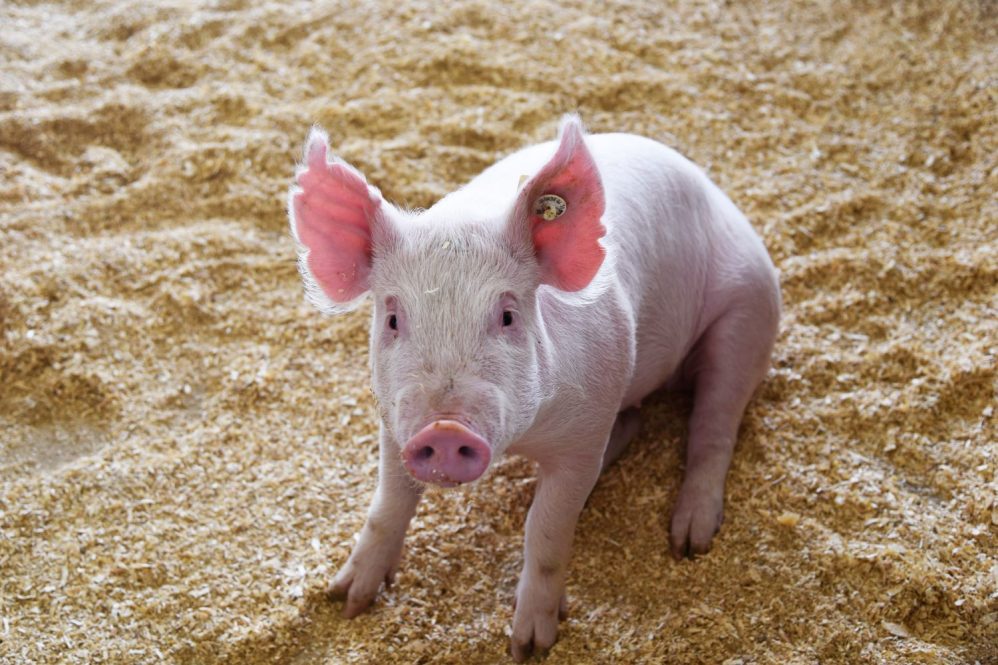Porcine reproductive and respiratory syndrome viruses (PRRSV) cause significant damage to pig farms worldwide every year.
In the U.S. alone, PRRSV infections cost farmers an estimated $664 million annually. In Europe, the estimated yearly loss is €1.5 billion.
There is currently no effective treatment or prevention for this devastating disease. But there may be hope on the horizon.
A group of UConn-led researchers from the College of Agriculture, Health and Natural Resources recently identified a series of small molecules that could serve as an effective preventative treatment for PRRVS. The team includes Xiuchun “Cindy” Tian, interim department head and professor of animal science; Jiaqi Zhu ‘23 (CAHNR), a former Ph.D. student in animal science; Antonio Garmendia, professor of pathobiology and veterinary science; and Young Tang, former associate professor of animal science at UConn and current faculty at Northwest A&F University in China.
The team recently published their findings in the Journal of Virology. It was selected as the editor’s choice for the issue.
“This is an economically important infectious disease among the pig industry, and it causes significant loss in the businesses,” Zhu says. “So, we wanted to find a therapeutic strategy against this disease.”
The team used an innovative approach for screening potential pharmaceuticals that focused on small molecules rather than traditional vaccination approaches.
Scientists previously discovered that the viruses target a specific receptor on the pigs’ cells, CD163, to infect the cell. In this study, the collaborator, Atomwise Inc., used their AI based technology to identify a set of small molecules, from a library of millions of compounds, which the researchers then screened for blocking PRRSV attachment to CD163 in the laboratory.
Atomwise is a California-based tech-enabled drug discovery company that pioneered the use of deep learning for structure-based drug design to identify which small molecules bind to target proteins with 3D models.
“It’s like a lock-and-key mechanism,” Tian says. “The lock has to be opened by a specific key. They interact very uniquely and closely.”
The researchers marked the receptor, the “lock,” with a half of fluorescent marker that would only show up if it found another half of fluorescent marker on the “key,” in this case, a specific viral protein. If the small molecule interferes with the lock-key interaction, then it blocks infection.
The researchers first identified one small molecule that could significantly decrease viral infection in their cell model.
Atomwise’s algorithm then searched for other candidates and identified a group of 96 analogs of that molecule. Analogs are compounds that have similar chemical structures. This often means they perform similar functions in the body or environment.
The researchers found three other molecules that had the same protective impact as the original.
The molecules effectively inhibited the interaction between the virus and the cell receptor by binding to a fragment of the receptor, providing strong immunity.
Thanks to their collaboration with Atomwise, the team’s findings represent a new approach to preventing PRRSV infection. Previously, researchers had been working on traditional vaccines which did not provide strong protection and are expensive to produce. PRRSV is also highly mutating in nature, which makes developing an effective vaccine a moving target.
Small molecules are much easier and cheaper to produce and store. This is a great advantage of a product that would potentially need to be mass produced for farmers on a global scale. Small molecules could also be added to pig feed to inoculate the pigs en masse, rather than having to individually vaccinate thousands of piglets.
The next step is to test all four molecules in animal models. While all four molecules worked equally well in the cell model, when they are tested in animals, different advantages and disadvantages may emerge. The team will experiment with different dosages of each molecule as well to determine the ideal formulation for a new preventative treatment.
UConn and Atomwise have filed a patent application and, UConn is currently exploring potential industry partnerships to further mature and license this technology.
“If the PRRS virus, one of the biggest problems in the pig industry, has a preventative measure that is cheaper and more effective, that is going to be very impactful among the farming community,” Tian says. “This has tremendous impact globally.”
This work relates to CAHNR’s Strategic Vision area focused on Ensuring a Vibrant and Sustainable Agricultural Industry and Food Supply.
Follow UConn CAHNR on social media



